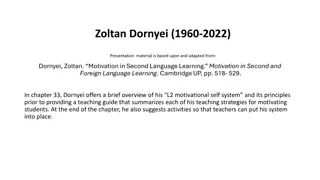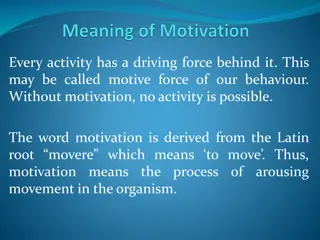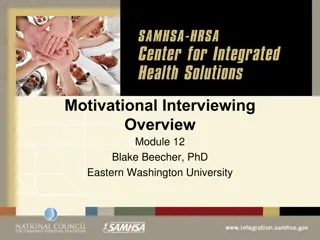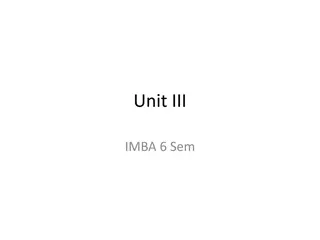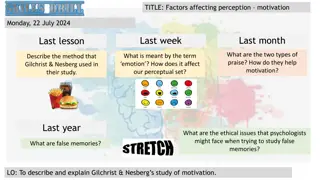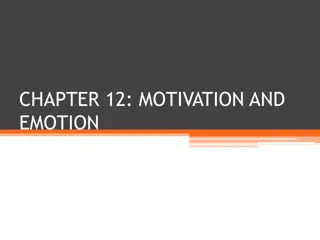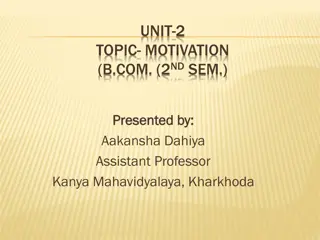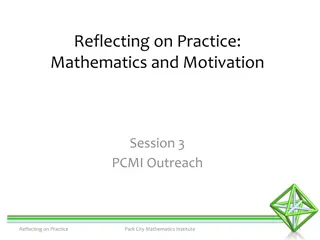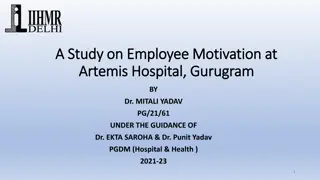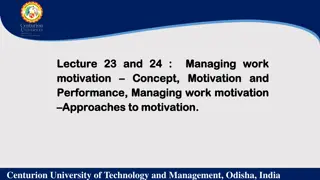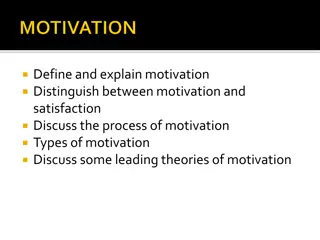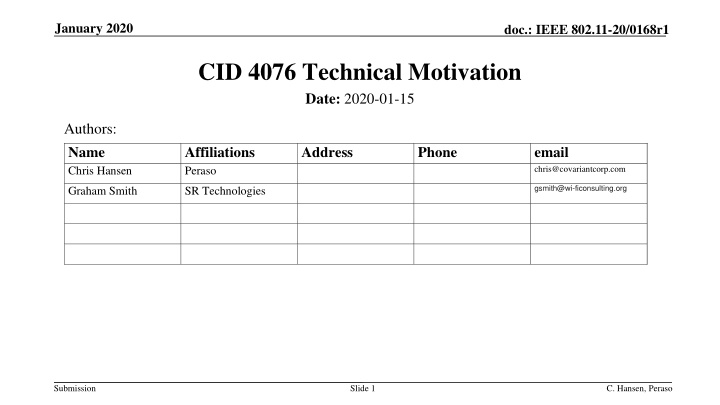
Enhancing 802.11 Networks with 8PSK Modes: Technical Motivation and Implementation
Explore the technical motivation behind introducing 8PSK modes for the DMG SC PHY in IEEE 802.11 networks. Understand the benefits of using 8PSK over 16 QAM, such as increased signal-to-noise ratio and better power efficiency. Discover how this change can enhance backhaul applications in 60 GHz frequency bands.
Download Presentation

Please find below an Image/Link to download the presentation.
The content on the website is provided AS IS for your information and personal use only. It may not be sold, licensed, or shared on other websites without obtaining consent from the author. If you encounter any issues during the download, it is possible that the publisher has removed the file from their server.
You are allowed to download the files provided on this website for personal or commercial use, subject to the condition that they are used lawfully. All files are the property of their respective owners.
The content on the website is provided AS IS for your information and personal use only. It may not be sold, licensed, or shared on other websites without obtaining consent from the author.
E N D
Presentation Transcript
January 2020 doc.: IEEE 802.11-20/0168r1 CID 4076 Technical Motivation Date: 2020-01-15 Authors: Name Chris Hansen Affiliations Peraso Address Phone email chris@covariantcorp.com gsmith@wi-ficonsulting.org Graham Smith SR Technologies Submission Slide 1 C. Hansen, Peraso
January 2020 doc.: IEEE 802.11-20/0168r1 Abstract Technical motivation for 8PSK modes for the DMG SC PHY Submission Slide 2 C. Hansen, Peraso
January 2020 doc.: IEEE 802.11-20/0168r1 Outline Background Proposed new constellations and code rates Simulation Results Changes to 802.11md Clause 9 and Clause 20 to Implement 8 PSK Summary Submission Slide 3 C. Hansen, Peraso
January 2020 doc.: IEEE 802.11-20/0168r1 Background (1) The primary market today for Clause 20 / DMG STAs is backhaul 60 GHz backhaul applications will benefit from greater range Backhaul typically uses highly directional antennas Resulting channel has few reflections and therefore low inter-symbol interference Range is limited by available transmit power and required receiver SNR Friis Equation and the definition of receiver signal-to-noise ratio Combine and solve for range, R, as a function of SNR and transmitter power Submission Slide 4 C. Hansen, Peraso
January 2020 doc.: IEEE 802.11-20/0168r1 Background (2) Combined Equation Range is limited by the square root of the ratio of available transmit power to required SNR at the receiver By using 8 PSK instead of 16 QAM for MCS 10 and 11, we can greatly increase this ratio Submission Slide 5 C. Hansen, Peraso
January 2020 doc.: IEEE 802.11-20/0168r1 Background (3) DMG contains moderate rate MCS modes with 16 QAM constellations QAM modulation will increase the peak to average ratio of transmitted signals relative to PSK modulations Practical transmit power amplifiers can transmit much more power using PSK modulation Submission Slide 6 C. Hansen, Peraso
January 2020 doc.: IEEE 802.11-20/0168r1 Background (4) For a given constellation, the peak power is the power of the constellation point at the greatest distance from the origin (center). The average power is the mean over all constellation points. Circular constellations, such as 8 PSK have a peak power equal to the average power. Thus, their peak-to-average power ratio (PAPR) is minimized 16 QAM PAPR = 18/10 = 2.55 dB 16 QAM PAPR = 18/10 = 2.55 dB 8 PSK PAPR = 1/1 = 0.0 dB 8 PSK PAPR = 1/1 = 0.0 dB Submission Slide 7 C. Hansen, Peraso
January 2020 doc.: IEEE 802.11-20/0168r1 Background (5) Compression of QAM signals in non-linear components, such as mmwave power amplifiers, low noise amplifiers, and mixers, will also have greater impact on QAM signals than it will on PSK signals Compression tends to reduce the minimum distance between outer constellation points and increases the average EVM (error vector magnitude) Since bit error rate is a function of minimum distance, the bit error rate increases more for QAM Submission Slide 8 C. Hansen, Peraso
January 2020 doc.: IEEE 802.11-20/0168r1 Background (6) 8PSK and 16QAM shown with EVM = -19 dB 16 QAM has a much higher peak-to-average ratio and requires a much greater back off from amplifier saturation This results in a lower transmitter power for 16 QAM. Submission Slide 9 C. Hansen, Peraso
January 2020 doc.: IEEE 802.11-20/0168r1 Background (7) 16QAM constellation after distortion created with the Rapp Model in the 802.11ay Evaluation Methodology 4.8 dB backoff -19 dB EVM Submission Slide 10 C. Hansen, Peraso
January 2020 doc.: IEEE 802.11-20/0168r1 Background (8) 8 PSK Constellation -1.0 dB backoff -19 dB EVM Even at a higher average output power, the 8PSK constellation is more tolerant of amplifier distortion than 16 QAM Submission Slide 11 C. Hansen, Peraso
January 2020 doc.: IEEE 802.11-20/0168r1 MCS 10 and 11 with 8PSK (1) 8 PSK constellations with higher code rates can be employed instead of 16 QAM constellation with lower code rates MCS 10: 8 PSK with a rate 2/3 code instead of 16-QAM with rate code Rate 2/3 code is generated by shortening the Clause 20 rate LDPC code On encoding, pad 168 zero bits to fill the codeword Do not transmit pad bits No new LDPC code is needed Apply pi/2 phase shift per symbol to 8PSK the same way we do for existing DMG SC modulations Submission Slide 12 C. Hansen, Peraso
January 2020 doc.: IEEE 802.11-20/0168r1 MCS 10 and 11 with 8PSK (2) MCS 11 8 PSK with rate 5/6 code instead of 16QAM with rate 5/8 Shorten the draft 802.11ay rate 7/8 code to rate 5/6 by padding with zeros to fill the information part of the codeword Padded zeros are not transmitted New LDPC code matrices are not needed Shortening code words is already a part of 802.11 Submission Slide 13 C. Hansen, Peraso
January 2020 doc.: IEEE 802.11-20/0168r1 MCS 10 Simulation Results MCS 10 PER with 4096 byte packets, phase noise, and PA distortion. EVM = -19 dB 10 iterations on LDPC decoder 8 PSK requires 0.6 dB greater SNR at 1% PER 8 PSK TX power is 3.9 dB higher Range increase of 47% Submission Slide 14 C. Hansen, Peraso
January 2020 doc.: IEEE 802.11-20/0168r1 MCS 11 Simulation Results (1) MCS 11 PER with 4096 byte packets, phase noise, and PA distortion. EVM = -20 dB 10 iterations on LDPC decoder 8 PSK requires 2.1 dB greater SNR at 1% PER 8 PSK TX power is 4.0 dB higher Range increase of 27% Submission Slide 15 C. Hansen, Peraso
January 2020 doc.: IEEE 802.11-20/0168r1 Proposed Changes to 802.11md D3.0 Add options to use MCS 10 and 11 with 8-PSK instead of 16-QAM Signal the capability to employ this option in the DMG Capabilities Field (9.4.2.127) 1 bit required - Many bits available in the Supported MCS Sub-field Signal the use of this option in the DMG SC Mode PPDU Header (Table 20-13 in 20.5.3.1.1) Under discussion. Possibilities include: Bit 47 of the DMG SC Header is unused Bit 45 of the DMG SC Header is also unused in Clause 20. A similar header in Clause 24 PHY (CDMG) uses bit 45, but this PHY has a different symbol rate, so there are no possibility of misinterpretation of the bit by CDMG STAs. Unused MCS values in DMG SC Header Use existing LDPC codes with shortening (additions to 20.5.3.2.3 Encoding) Add 8-PSK modulation to 20.5.3.2.4 Modulation mapping Submission Slide 16 C. Hansen, Peraso
January 2020 doc.: IEEE 802.11-20/0168r1 Summary 8 PSK has been evaluated using the phase noise, PA models, and EVM targets for DMG STAs Range increases of 27% to 47% are possible with MCS10 and MCS11 using 8 PSK instead of 16 QAM Existing Clause 20 LDPC codes can be shortened to achieve the rate 2/3 and rate 5/6 codes required for 8 PSK No new encoder / decoder Small additions to 802.11md Clause 9 and Clause 20 will be proposed to support 8 PSK operation Submission Slide 17 C. Hansen, Peraso
January 2020 doc.: IEEE 802.11-20/0168r1 Backup Submission Slide 18 C. Hansen, Peraso
January 2020 doc.: IEEE 802.11-20/0168r1 AWGN Channel Capacity Comparison From Bit- Interleaved Coded Modulation by G. Caire, G. Taricco, and Ezio Biglieri MCS11 (2.5 bits per symbol) MCS10 (2 bits per symbol) Submission Slide 19 C. Hansen, Peraso

